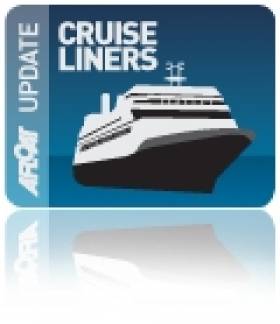Displaying items by tag: HighEnd Market
#SwoopSail - An impressive visitor to Dublin Port this weekend will be one of the world’s largest tall ships, the Spanish Navy’s trainee ship Juan Sebastián de Elcano, writes Jehan Ashmore.
Before the arrival of this striking four-masted majestic steel-hulled schooner at 370ft, a small cruise had taken up Berth 18 on the North Wall Quay extension. This is located next to the Tom Clarke Toll-Bridge where last weekend at this berth was occupied Swoop-Antartica's high-end luxury cruiseship Hebridean Sky. As previously reported those on board had elevated views of the Dublin Riverfest Bank Holiday held event in which other cruiseships were also in port.
The all-suite ship of five decks was renovated in 2016 at a cost of $10 million. The upgrade work is reflected with these only outward facing cabin suites.
At around 4,200 gross tonnage, this 90m ship is certainly small given the ever increasingly giants in service or that are on order. The 1992 Italian built Hebridean Sky, however belongs to a league of small intimate vessels where guests expect high levels of luxury based on this 5-star experience cruiseship.
Spacious cabins ranging from 20 - 34 sq m (215 - 366 sq ft), including a capacious Owner's Suite, dedicated single cabins and the option of outside balconies in the higher cabin categories
Each of the ‘suite’ accommodation is at least 225 square ft. They offer a choice of either twin- or queen-sized bed, flat-screen TV, mini-bar and sitting area with a sofa-bed. Also included are independent temperature controls and a marble-appointed en-suite bathroom.
As Hebridean Sky is an adventure ship cruising Antarctica, stern step provides easy access into zodiacs as an alternative to the gangway. This cruise in northern hemisphere, saw the ship depart Dublin where the vessel made a call to Waterford yesterday before calling to Portsmouth today.
The ship under a different guise, Sea Explorer had spent a lay-over period while berthed in Dun Laoghaire Harbour. On that occasion several years ago, the vessel was alongside St. Micheals Pier, where recently the private charter motor-yacht veteran Talitha called for maintenance repairs.
High-End Market Cruise Callers to Visit Shannon Season 2015
#CruiseCallers – A pair of cruiseships from the high-end of the luxury market, are to visit the Shannon Estuary with calls to Foynes Port in the 2015 season, writes Jehan Ashmore.
According to Shannon Foynes Port Company, the cruise calls will both take place in May with Compagnie du Ponant's mega-yacht styled cruiseship Le Boréal followed within the same week by the six-star Silver Whisper.
Le Boréal only takes a maximum of 264 passengers pampered in luxurious and intimate surroundings from the hand of French designer Jean-Philippe Nuel. The 142m vessel built by Italian shipbuilding group Fincantieri has up to 132 cabins and all are outside.
The leadship of a quartet was rewarded 'Best New ship of the Year 2010' by the European Cruiser Association.
Silver Whisper, a Millenium class vessel of the SilverSeas Cruises accommodates for 382 guests. The operators of 28,258 tonnes cruiseship, offers a highly individualized service.
The floating resort includes shopping experiences to that of a boutique hotel. In The Telegraph - Ultratravel 100 Awards, the company were awarded 'Best Small Luxury Cruise Line' 2014.





























































